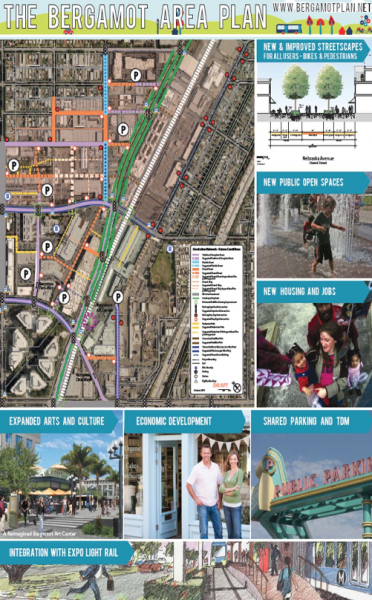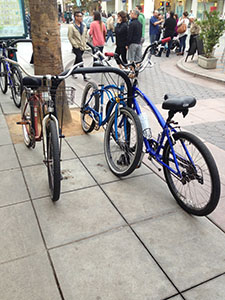Santa Monica Moves Forward With Transit-Oriented Neighborhood

The neighborhood includes affordable housing initiatives and several commercial endeavors in the private sector, like the recently approved Hines project, according to the project website.
Right now, the streets in the Bergamot area are predominantly lined with low-ceiling industrial warehouses and peppered with small cafes and art galleries. Around midday, small groups of employees emerge from the warehouses and walk to nearby Pennsylvania Avenue to grab lunch from the food trucks that line up there.
“Santa Monica always had a festive and popular beachside community,” said local historian, Kevin Starr. “The industrial developments in the area were all very cerebral pursuits.”
The Bergamot area is currently an industrial hub for some of those cerebral pursuits. Nicknamed “Silicon Valley by the sea,” the area is occupied by innovative businesses like Neon Wolf, a website designer, and FirstCom Music, a music company, who have transformed the warehouses into creative innovation centers.
“We want to give them the ability to expand, but not to tear down the buildings," said Bar-El. "They are not historic landmarks but they’re important for the character of the area."
She said the businesses provide good jobs and one of the aims of the Bergamot project is to provide some of these companies with the opportunity to expand into bigger spaces.
READ MORE: Latest Metro Expo Line A Sluggish Disappointment For L.A. Commuters
Brimming with museums and art galleries, the Bergamot area has also developed a unique artistic culture that Bar-El said she wants to maintain throughout the implementation of this plan. “The idea of the Bergamot project is to create a new transit-oriented neighborhood, but to keep the original flavor of the neighborhood.”
One of the most important factors at play for modern urban development projects is smooth integration, according to Eric Heikkila, an expert in urban development.
“Urban development is contextual," said Heikkila. "The challenge is to develop projects that fit well into the existing urban context...We want to create a new transit-oriented neighborhood that respects and enhances the creative culture in the area.”

The bike-share program is similar to those already implemented in many European cities and has already been awarded a grant. Bar-El said the program would give residents the opportunity to rent bikes from the Expo Station and ride to other parts of the city, returning the bikes at any bike share station citywide.
READ MORE: Santa Monica Leads On Bike Share, But Is Willing To Let The Region Catch Up
Despite its development in conjunction with the community and the city, the Bergamot project has been a sore spot for city officials at the approval meeting and a local renter's rights group.
Councilman Kevin McKeown expressed concern that, based on information from the planning committee about likely wages, housing in the area is not affordable enough for many of the people who will be living and working there.
“If we create a disparity between what the jobs are, and we don’t control waging, and the housing, where we can to some extent control rent,” said McKeown. “We undo all the good sustainability behind creating a neighborhood where jobs and housing are collocated.”
Starr points to the beach culture as one of the reasons Santa Monica has been slow to develop industrially. “Industrial development is not in the DNA code of Santa Monica,” he said.
According to Heikkila, the city’s history may be where this friction stems from. “Santa Monica is renowned for its environmental quality and distinctive lifestyle. The challenge for developers is to create industrial spaces that can enhance this pre-existing urban context. That is also a political challenge, because communities may mobilize against projects that they might deem detrimental.”

One such community mobilizing against the Bergamot project is Santa Monicans for Renters Rights or SMRR. According to its website, SMRR is “tough on development” and has voiced concerns that the Bergamot project does not incorporate enough residential housing and may not reduce traffic in the area as intended.
In a letter, SMRR Co-Chair Patricia Hoffman urged the city council not to approve one of the Bergamot area’s new private development plans, known as the Hines project.
Hoffman said the proposed 400,000 square feet of office space “will exacerbate the problem of too much peak hour traffic in the most traffic-congested corridor of the city.”
She also addressed the organization’s housing concerns with the Bergamot project by urging the council to negotiate a “principally residential” project instead.
Bar-El said she is not quite sure what SMRR is talking about. “There is a potential for a very large number of residential spaces if the private sector chooses to build them. We already have two projects on the way that will bring several hundred units with them,” she said.
Bar-El said some of the next steps of the implementation process are writing a proposal for the bike-share program, acquiring public funding for road construction and infrastructure updates and continuing the development process with businesses in the private sector hoping to join the Bergamot neighborhood.
Reach Staff Reporter Kaitlyn Mullin here or follow her on twitter here.



